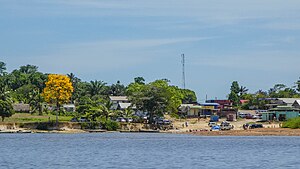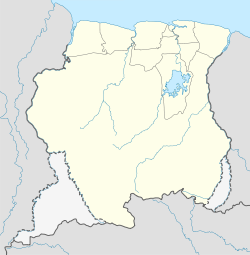Pokigron
Pokigron | |
|---|---|
 The village from the Upper Suriname River | |
| Coordinates: 4°29′28″N 55°21′54″W / 4.491111°N 55.365°W | |
| Country | |
| District | Sipaliwini |
| Resort (municipality) | Boven Suriname |
| Elevation | 246 ft (75 m) |
| Population (2018)[1] | |
• Total | ~400 |
Pokigron is a town in Suriname located on the Upper Suriname River near the Brokopondo Reservoir. It is located in the Boven Suriname municipality (resort) in the Sipaliwini District. It has a population of approximately 400 people in 2018.[1] Pokigron is located at the end of a paved road via Brownsweg to the Avobakaweg.[2] Pokigron is often referred to as Atjoni which is the nearby quay, and literally the end of the road. Villages to the South of Pokigron have to be accessed by boat.[3] The village is home to Maroons of the Saramaka tribe.[4]
Nearby towns and villages include Wittiehede Ston (19.6 nm), Mofina (15.6 nm), Wittikamba (1.4 nm), Malrosee-Kondre (5.1 nm) and Abenaston (3.0 nm).[5]
History
[edit]Pokigron was, up to 1986, a village with a population of 700, and reasonably prosperous as the main transport hub to the south of the country. Many of the typical huts with thatched roofs had been replaced by houses, and the village even had street lights. This changed on 23 April 1987.[6] The Surinamese Interior War which had started far away in Albina and Moengotapoe the previous year, had come to Sipaliwini.[7] The Jungle Commando headed by Ronnie Brunswijk ordered the villagers into the jungle, robbed them of their possessions, and burned their houses.[6] On 11 September 1987, the National Army led by Dési Bouterse retaliated by attacking the Jungle Commando, and according to a report by Aide Médicale Internationale, killed civilians including women and children. Both parties have denied that any civilians had been killed.[8] On 27 September 1989, the Inter-American Commission on Human Rights looked into the matter, declared that this constituted a very serious violation of the Right to Life, recommended that the Government of Suriname investigate the matter, and that the relatives of the victims are entitled to fair compensation. The IACHR identified 15 cases of deaths, four disappearances and one was unclear. Six of the cases were children, and three were women of which one was raped before she was killed.[9] In October 1993, the IACHR sentenced the Government of Suriname to pay $400,000 (~$761,926 in 2023) in damages to the victims.[10]
A group of civilians from Pokigron following the incidents squatted[6][11] in a terrain near Paramaribo, and have named their camp Sunny Point.[11] It is located in Koewarasan, Wanica.[12]
As of 3 February 2018, the village of Pokigron now has 24 hours of electricity, because the Diesel generators could only provide for 5 to 6 hours.[1]
Healthcare
[edit]Pokigron is home to a Medische Zending healthcare centre.[13]
References
[edit]- ^ a b c "Pokigron 1×24 uur stroom". De Boodschap.today (in Dutch). Archived from the original on 10 July 2019. Retrieved 20 May 2020.
- ^ "Suriname ontvangt geld van China om financiering project". Indian Feelings (in Dutch). Retrieved 14 May 2020.
- ^ "Welcome to the Jungle". Vives Onderwijs in Suriname (in Dutch). Retrieved 20 May 2020.
- ^ "Planning Office Suriname - Districts" (PDF). Planning Office Suriname (in Dutch). p. 189. Retrieved 13 February 2021.
- ^ "Pokigron". Map Landia. Retrieved 19 May 2020.
- ^ a b c "De ondergang van een Surinaams bosnegerdorp". Terdege via Digibron (in Dutch). 2 January 1991. Retrieved 20 May 2020.
- ^ "Leger Suriname zoekt gijzelaars". Reformatorisch Dagblad via Digibron. 26 July 1986. Retrieved 19 May 2020.
- ^ "Franse artsen melden nieuw bloedbad in dorp Suriname". Reformatorisch Dagblad via Digibron (in Dutch). 29 September 1987. Retrieved 20 May 2020.
- ^ "Tjongalangapassie victims v. Surin., Case 10.124, Inter-Am. C.H.R., Report No. 22/89, OEA/Ser.L/V/II.76, doc. 10 (1988-1989)" (PDF). World Courts. 27 September 1989.
- ^ "'BOUTERSE HOORT IN THE BAK'". Trouw via Delpher (in Dutch). 24 September 1994. Retrieved 20 May 2020.
- ^ a b "Wat wij doen in Sunny Point". Kansrijk Suriname (in Dutch). Retrieved 20 May 2020.
- ^ "Nikos-peiling: Onveiligheidsgevoel in Wanica toegenomen". Star Nieuws (in Dutch). Retrieved 20 May 2020.
- ^ "Zorggebied". Medische Zending.sr (in Dutch). Archived from the original on 30 September 2022. Retrieved 19 May 2020.

